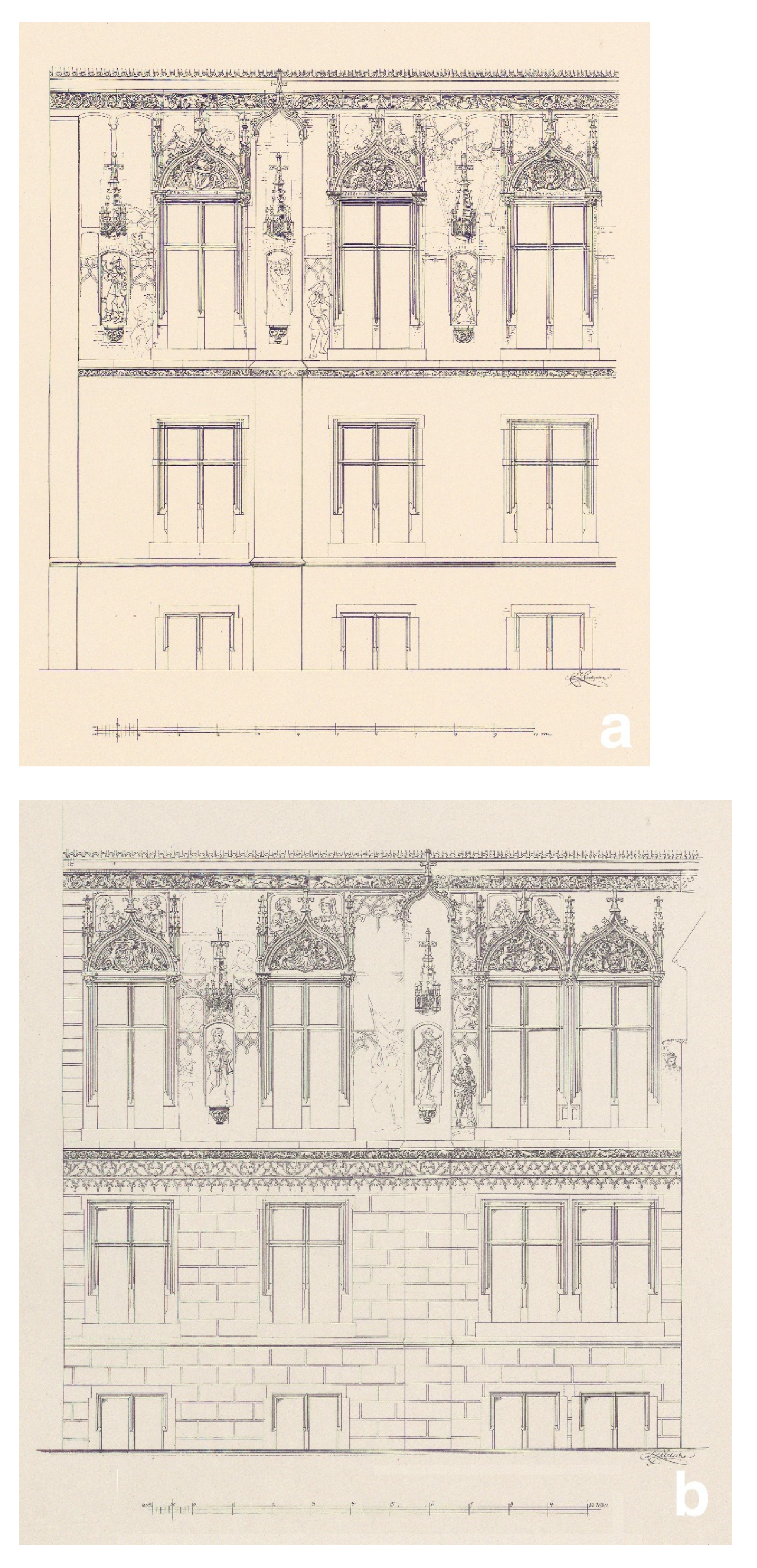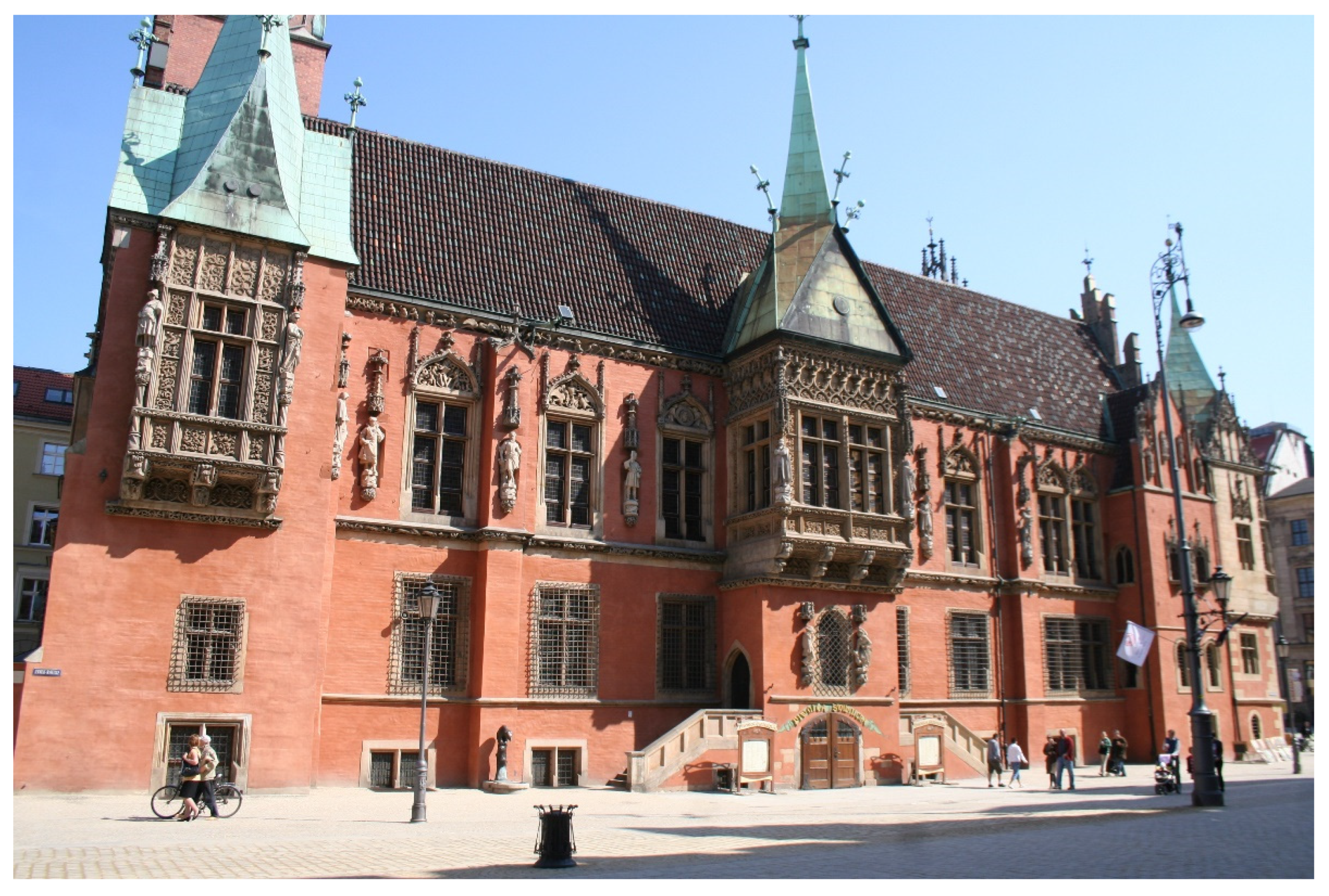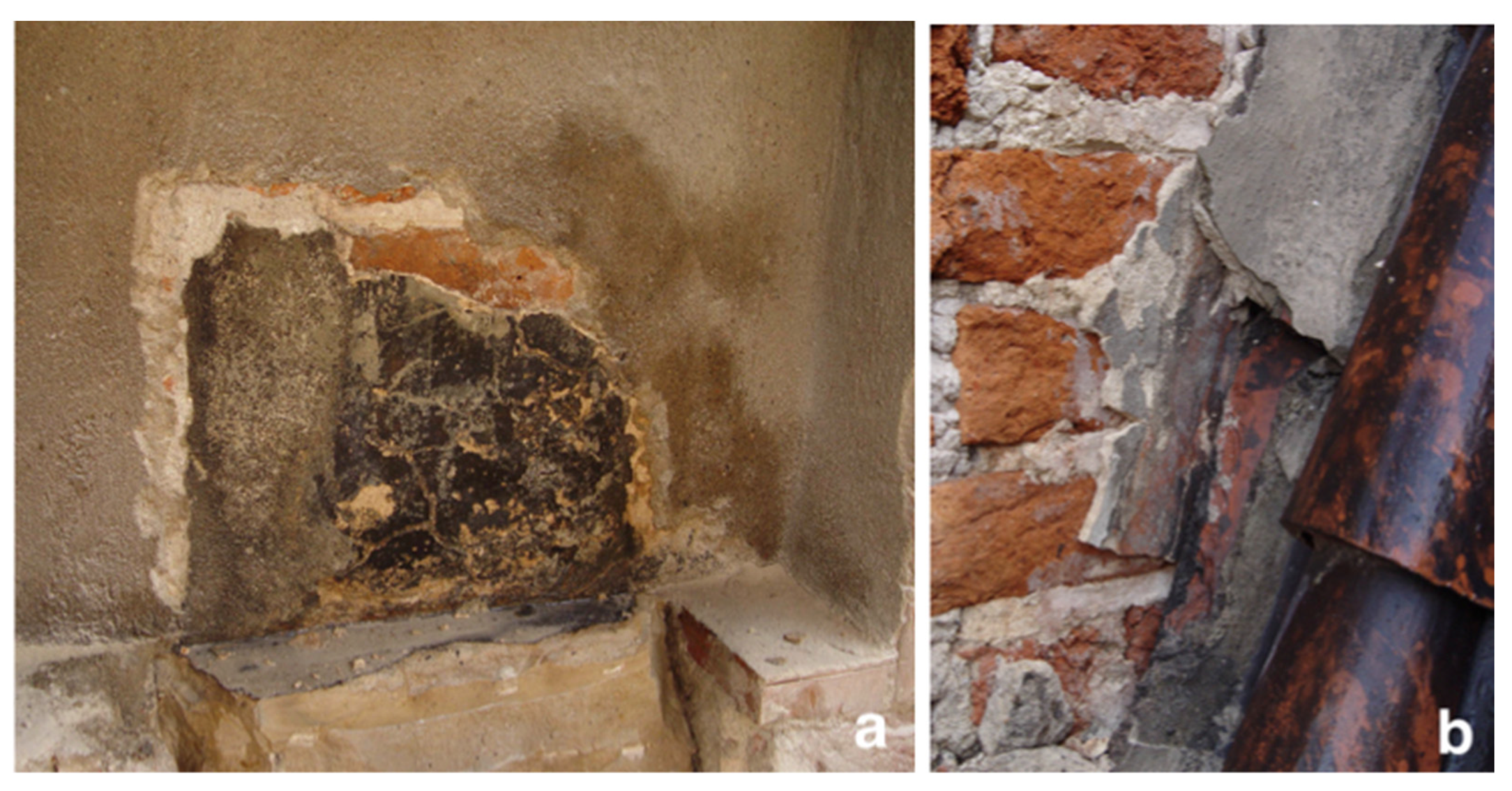2.3. The Third Phase of Constructing the Façade and the First Colour Phase (1471–1486)
The construction of the Town Hall’s present southern nave and the central and western avant-corps was probably completed in the years 1471–1486 (
Zlat 1976, pp. 83, 89). The façade was composed of seven axes: three axes in the western part, and four in the eastern part. Its division was accentuated by a central bay window.
The present southern façade was rebuilt after the previously existing southern part between the two avant-corps located on the western and eastern edge of the Town Hall was dismantled to the basement level. The wall was erected at the same time as the central avant-corps in one construction action. The construction of the brick walls began with the building of pillars between the windows. Stone profiled frames for the rectangular windows were embedded in the openings. The openings of the ground floor and first floor windows were divided by a stone pillar and a muntin in the form of a Latin cross. A reinforcement in the form of construction arches with a thickness of one brick was made above the basement openings and on the ground floor.
The western avant-corps was also rebuilt. Its walls were dismantled to a height of about 5.70 m. The framing of the ogival opening on the southern wall was removed, and the opening itself was blocked with a brick wall and stone blocks. Parts of the ground floor were also rebuilt by extending the avant-corps to the west by 1.2 m. The form of the eastern avant-corps was also changed. Its south-west diagonal wall was dismantled to the level of the Market Square. The same was done with the vault, which was bricked up. The perimeter walls were built up to the present height. The southern façade on the first floor has two axes and two ogival window openings, which were probably decorated with stone tracery. The façade was finished with a triangular gable with ancillary columns, and lesene that was decorated with pinnacles. Moreover, a richly decorated bay window, supported on corbels, was placed in the east. A similar form was given to the bay window that crowns the central avant-corps, as well as to the one to the west that is more modest in its form (
Figure 4).
Brick pillars between the windows and buttresses at the level of the first floor were reinforced by introducing recesses that were closed with a segmental arch. The recesses are decorated with stone consoles and canopies. They were probably prepared for the placement of stone sculptures, which are currently not preserved. In the middle of the length of both sections of the façade (between the avant-corps), there are two narrow buttresses crowned with stone covers in the form of an ogee-shaped arch. In the upper part of the western buttress, there is a stone gargoyle of simple form, which is the mouth of a roof gutter.
The façade at the basement level has nine window openings with stone framings. In the first and ninth axes (from the west), there are large window openings with more decorative bands. The entrance to Piwnica Świdnicka is situated in the central avant-corps. It has a sectional shape and is framed with stone profiled framing. On the ground floor, there are twelve window openings arranged in ten axes. In the eighth and tenth axes, the windows are double. Apart from the avant-corps, the windows with stone bands are placed on a drip cornice. Their openings are divided into four areas by a muntin of a Latin cross shape. In the central avant-corps, above the entrance to the basement, there is a large window opening with a semi-circular arch. The window is flanked by two sculptures that show a genre scene: a drunk journeyman and an angry wife. The sculptures are placed on consoles that have representations of animals, which symbolize the mood of each character: two bears drinking honey (under the man), and two biting dogs (under the woman). Above the figures, there are canopies with pinnacles topped with flowers. The composition of the first floor includes thirteen rectangular window openings that are framed in stone profiled bands, and which have their openings divided into four fields with a muntin of a Latin cross shape. The windows of the central bay window, as well as those in the eighth axis (counting from the west), are doubled.
The openings, which are arranged within the main wall, are set on a drip cornice and topped with tympana in the shape of an ogee arch. They are flanked by a pair of pinnacles topped with flowers. The tympana have a sculptural decoration with a heraldic theme and with elements of the five-field coat of arms of Wrocław. Starting from the west, there is a shield with the letter “W” held by “wild men” in the second axis (
Figure 5); in the next axis there is a shield with an eagle with a crescent moon on its chest, which is held by two eagles with raised wings; and in the fourth axis there is the head of St. John the Baptist in a bowl with the date 1483 on its frame, which is held by two kneeling angels. The decorations of the eastern part of the tympana are: an eagle with a crescent on its chest, which is supported by griffins; an eagle on a shield between a pair of eagles with raised wings; a lion with a split tail on a shield between two other lions; and in the last shield there is the head of St. John the Evangelist between a pair of standing angels. The two openings within the eastern avant-corps are shaped as ogival bay windows, which are placed on windowsills supported by a pair of monkeys and dragons.
The cornice under the windows of the first floor is decorated with an openwork floral ornament with figures that depict urban genre scenes: a fight in an inn (
Figure 6a), a duel with wooden swords (
Figure 6b), musicians playing the pipe and violin (
Figure 6c), and two men playing dice. There are also animals: dogs fighting each other, deer running away from a pack of dogs, a lion biting its prey (
Figure 6d), lonely animals such as a deer with its antlers tangled in branches (
Figure 6f), and also animals related to fairy tales, such as a stork giving a fox food in a high jug (
Figure 6e). The crowning cornice, which is much higher, also received a similar thematic decoration. It shows genre scenes that are interwoven with fleshy plant twigs: a woman being carried on a wheelbarrow (
Figure 7a), a woman being carried in a basket, travellers with a dog, riders fighting on lances (
Figure 7b), a knight killing a dragon, knights fencing, knights having a duel with two-handed swords (
Figure 7c), a deer hunting scene (
Figure 7d), as well as images of animals: two fighting eagles, a deer and a bear.
The façade has distinctive decorated bay windows in three avant-corps (
Figure 5). Two of them (west and middle) are covered with carpet ornaments with floral and geometric motifs. In the corners of the bay windows there are cantilevers for figural sculptures. The cantilevers have engraved angels, and below them there are figures of townspeople, e.g., a trumpeter, a piper, and an innkeeper. The most decorative central bay window is enhanced in its upper part with a strip of ogee-shaped arches, which is decorated with flowers. The eastern bay window is topped with a roof framed by triangular gables with ogival tracery and coats of arms: with the Jagiellonian Eagle (west side), with the head of St. John the Evangelist (east side), and the Czech Lion (in the crowning). The east part of this window is decorated with intertwining ogee-shaped arches topped with pinnacles, and its southern part has a window tympanum with intertwining ogee-shaped arches. The second southern gable of the bay window is decorated with pinnacles. Between these decorations, there are four figures of saints: Andrew, Elizabeth, Mary Magdalena, and Lawrence. Below, between the bay windows of the first floor, there is a sculpture of St. Christopher, and at the height of the inter-story cornice there is a sculpture of St. John the Baptist. The rich sculptural decoration of the bay window and the façade was made by the master Briccius Gauske (
Zlat 1976, p. 90).
The remains of the colours registered on the brick surface and the stone detail give an idea of the colour design of the façade. Traces of red colour, which were found in many places (directly on bricks and joints, on stone elements, and on bossage) indicate that the façade was painted in iron red (
Figure 8a). At the crockets on the pinnacles flanking the tympana (
Figure 8c), and in the bends of the profiled framing, traces of iron red were found directly on the stone. In addition, at least three colours were found on the surface of the stone within the tympana and the heraldic representations that were composed in them (
Figure 8b,d). Iron red was also spotted in the backgrounds of the tympana, the folds of the sashes, and on the shield with the representation of the Lion with a split tail (the coat of arms of the Czech Kingdom). Black was found on the bends between the feathers of the Eagle with a crescent on its chest (the coat of arms of Silesia). In turn, white was found between the feathers of the Eagle on the shield and between its two supporting eagles (the Jagiellonian coat of arms), in the folds of the robes of the angels who support the shield with the head of St. John the Evangelist, and also in the folds at the outer edges of the sashes. The preserved remains of the painting indicate that the façade, completed in 1486, was entirely painted with red monochrome, with the architectural detail being emphasized with iron red. The elements of the coat of arms of Wrocław, which are placed in the tympana of the windows of the first floor, had a colour scheme that was in line with the heraldry (
Legendziewicz and Polak 2005, pp. 6–10, 17–19).
2.4. The Second Colour Phase (around 1510)
The late Gothic transformation of the southern façade of the Town Hall, completed in around 1510, mainly involved the introduction of painting decorations, which are known from the inventory made by Carl Lüdecke (
Lüdecke 1898;
Zlat 1976, p. 100). Moreover, within the southern façade of the eastern avant-corps, stone bay windows were introduced in the place of ogival openings.
The painted decoration of the southern façade is probably the last medieval stage of the reconstruction of the seat of the municipal authorities. The strip of the first floor in the eastern part has multi-coloured views that symbolize the city during times of peace, and also has representations of various urban states (including townspeople, a street musician, a guard leaning on a halberd, and a bear playing a bagpipe). In turn, the western part shows the city during war, with images of the walls being conquered (including a soldier climbing a ladder, and defenders throwing stones and firing a crossbow). The entire ground floor is covered with a rectangular plasterwork motif, and the inter-story cornice is enhanced by a painted frieze with motifs: rosettes, a fish’s swim bladder, and ogival tracery.
Unfortunately, after the removal of the layers of cement plaster, only three fragments of traces of this decoration were recorded. Two areas of about 40 cm/40 cm were found in the recesses between the windows of the first floor. In one of them, a fragment of a red frame was found surrounding the blende area, which was painted black, and which originally constituted the background for the figural decoration (
Figure 9a). A small strip of plaster was also found above the roof of the eastern avant-corps (
Figure 9b). A fragment of the lower edge of the motif painted in white was discovered there. The plaster was made of sand-lime in a pink-sand colour with visible small lumps of not fully slaked lime. The thickness of the plasters ranged from about 5 to 7 mm, and they had a slightly uneven (wavy) texture due to their surface being smoothed with a trowel (
Legendziewicz and Polak 2005, p. 9).



















